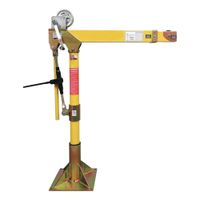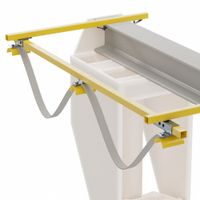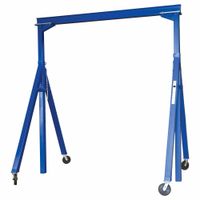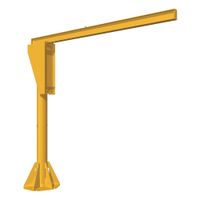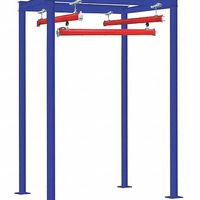Call +(254) 703 030 000 / 751 483 999 / 721 704 777
- Home
- Material Handling
- Lifting Pulling Positioning
- Cranes Festoon Cable Systems
.....Read More
Frequently Asked Questions
What are the main differences between davit cranes and jib cranes?
Davit cranes and jib cranes are both types of lifting devices, but they have distinct differences in design, application, and functionality.
1. **Design and Structure**:
- **Davit Cranes**: These cranes have a vertical mast and a horizontal boom that can pivot. They are typically smaller and portable, designed for lighter loads. The boom can be rotated manually or mechanically, and the crane is often mounted on a base or pedestal.
- **Jib Cranes**: These cranes consist of a vertical support (mast) and a horizontal arm (jib) that extends out. The jib can rotate around the mast, usually up to 360 degrees, depending on the design. Jib cranes are generally larger and can handle heavier loads compared to davit cranes.
2. **Applications**:
- **Davit Cranes**: Commonly used in marine environments for lifting small boats, equipment, or cargo. They are also used in industrial settings for maintenance tasks or where space is limited.
- **Jib Cranes**: Widely used in industrial and manufacturing settings for material handling. They are ideal for repetitive lifting tasks and can be used in workshops, warehouses, and assembly lines.
3. **Installation and Mobility**:
- **Davit Cranes**: Often portable and can be easily moved or disassembled. They are suitable for temporary or flexible applications.
- **Jib Cranes**: Typically fixed installations, either floor-mounted or wall-mounted. They require a stable foundation and are used for permanent or semi-permanent applications.
4. **Load Capacity**:
- **Davit Cranes**: Generally have a lower load capacity, suitable for lighter loads.
- **Jib Cranes**: Designed to handle heavier loads, with capacities ranging from a few hundred pounds to several tons.
5. **Rotation**:
- **Davit Cranes**: Limited rotation, often less than 360 degrees.
- **Jib Cranes**: Can offer full 360-degree rotation, providing greater flexibility in movement.
How do festoon cable systems work in crane operations?
Festoon cable systems are integral to crane operations, providing a reliable method for managing and protecting the cables that supply power and control signals to the crane's moving parts. These systems consist of a series of trolleys or carriers that move along a track or beam, supporting and guiding the cables as the crane operates.
The festoon system typically includes a track or beam mounted parallel to the crane's path of movement. Attached to this track are trolleys, which are equipped with rollers or wheels that allow them to glide smoothly along the track. The cables are looped and suspended from these trolleys, ensuring they are neatly organized and free from tangling or damage.
As the crane moves, the trolleys travel along the track, allowing the cables to extend or retract as needed. This movement ensures that the cables remain taut and do not drag on the ground, which could lead to wear and tear or pose a safety hazard. The festoon system accommodates the crane's full range of motion, whether it is moving horizontally along a bridge or vertically with a hoist.
Festoon systems are designed to handle various types of cables, including electrical power cables, control cables, and even hoses for hydraulic or pneumatic systems. They are customizable to fit different crane configurations and can be made from materials suited to specific environmental conditions, such as corrosion-resistant materials for outdoor or marine applications.
Overall, festoon cable systems enhance the efficiency and safety of crane operations by ensuring that cables are properly managed, reducing the risk of damage, and minimizing downtime due to cable-related issues.
What are the advantages of using gantry cranes over other types?
Gantry cranes offer several advantages over other types of cranes, making them a preferred choice in various industrial applications:
1. **Versatility**: Gantry cranes can be used both indoors and outdoors, providing flexibility in different environments. They are suitable for a wide range of applications, from small workshops to large shipyards.
2. **Portability**: Unlike fixed cranes, gantry cranes can be moved to different locations within a facility. This mobility allows for efficient material handling across various workstations without the need for multiple cranes.
3. **Cost-Effectiveness**: Gantry cranes often require less structural support than overhead cranes, reducing installation costs. They can be a more economical option for facilities that do not have the infrastructure to support overhead systems.
4. **Ease of Installation**: Gantry cranes are relatively easy to install and dismantle, which is beneficial for temporary projects or when the crane needs to be relocated frequently.
5. **Load Capacity**: They can handle heavy loads, making them suitable for lifting large and bulky items. The design allows for even weight distribution, enhancing stability and safety during operations.
6. **Space Efficiency**: Gantry cranes do not require permanent floor space, as they can be moved out of the way when not in use. This feature maximizes the available workspace and can be particularly advantageous in crowded or limited spaces.
7. **Customization**: They can be customized to meet specific operational needs, including adjustable height and span, which allows them to accommodate various load sizes and shapes.
8. **Safety**: Gantry cranes are equipped with advanced safety features, such as anti-collision systems and overload protection, reducing the risk of accidents and enhancing operational safety.
These advantages make gantry cranes a practical and efficient choice for many industries, including manufacturing, construction, and shipping.
How do you determine the load capacity for a monorail crane system?
To determine the load capacity for a monorail crane system, follow these steps:
1. **Identify Requirements**: Determine the maximum weight of the loads to be lifted, including any potential future increases. Consider the type of materials, frequency of use, and operational environment.
2. **System Design**: Evaluate the monorail system design, including the beam, trolley, hoist, and supporting structures. Ensure they are suitable for the intended load and operational conditions.
3. **Material Selection**: Choose materials for the monorail components that can withstand the required loads. Consider factors like tensile strength, fatigue resistance, and environmental conditions.
4. **Structural Analysis**: Perform a structural analysis to assess the stress and deflection of the monorail beam under load. Use engineering principles and software tools to simulate load conditions and ensure the beam can handle the stress without excessive deflection.
5. **Safety Factors**: Apply appropriate safety factors to account for uncertainties in load estimations, material properties, and operational conditions. Common safety factors range from 1.5 to 2.0, depending on the application and industry standards.
6. **Compliance with Standards**: Ensure the design complies with relevant industry standards and regulations, such as those from the Occupational Safety and Health Administration (OSHA) or the American Society of Mechanical Engineers (ASME).
7. **Testing and Validation**: Conduct load testing to validate the system's capacity. This involves applying known loads to the system and measuring its performance to ensure it meets design specifications.
8. **Documentation and Certification**: Document the design, analysis, and testing processes. Obtain necessary certifications from relevant authorities to confirm the system's load capacity and safety compliance.
9. **Regular Maintenance and Inspection**: Implement a maintenance and inspection schedule to ensure the system remains within its load capacity over time, addressing wear and potential damage.
What are the key components of a jib crane?
A jib crane is a type of crane that uses a horizontal member (jib or boom) to support a moveable hoist, which is fixed to a wall or to a floor-mounted pillar. The key components of a jib crane include:
1. **Boom (Jib Arm):** The horizontal beam that supports the hoist and trolley. It can be fixed or can rotate to provide a wide range of motion. The boom is crucial for determining the reach and lifting capacity of the crane.
2. **Hoist:** The lifting mechanism that moves along the boom. It can be manual, electric, or pneumatic, and is responsible for raising and lowering the load.
3. **Trolley:** Mounted on the boom, the trolley allows the hoist to move horizontally along the jib arm. It can be manual or powered, providing flexibility in positioning the load.
4. **Pillar (Mast):** In free-standing jib cranes, the pillar is the vertical support structure that holds the boom. It is anchored to the floor and provides stability and support for the crane's operations.
5. **Wall Bracket or Base Plate:** For wall-mounted jib cranes, the wall bracket secures the crane to a vertical surface. In floor-mounted models, a base plate is used to anchor the pillar to the ground.
6. **Rotation Mechanism:** Allows the boom to rotate around the pillar or wall bracket. This can be manual or powered, enabling the crane to cover a circular area.
7. **End Stops:** Installed at the ends of the boom to prevent the trolley from running off the jib arm.
8. **Controls:** The system used to operate the crane, which can include pendant controls, radio controls, or a control panel.
These components work together to provide efficient lifting and material handling solutions in various industrial settings.
How can festoon cable systems improve crane efficiency?
Festoon cable systems enhance crane efficiency by providing a reliable and organized method for managing the cables and hoses that supply power and control signals to the crane's moving parts. These systems consist of a series of trolleys that travel along a track, carrying the cables in a looped configuration. This design offers several benefits:
1. **Reduced Downtime**: By preventing cable tangling and damage, festoon systems minimize the risk of cable-related failures, reducing maintenance needs and downtime.
2. **Enhanced Safety**: Proper cable management reduces the risk of accidents caused by loose or damaged cables, ensuring a safer working environment.
3. **Increased Lifespan**: By protecting cables from wear and tear, festoon systems extend the lifespan of the cables, reducing replacement costs and improving overall crane reliability.
4. **Improved Performance**: With organized cable management, cranes can operate more smoothly and efficiently, as there is less resistance and drag on the cables during movement.
5. **Flexibility and Adaptability**: Festoon systems can accommodate various cable types and sizes, making them suitable for different crane applications and allowing for easy upgrades or modifications.
6. **Space Optimization**: By keeping cables neatly organized and out of the way, festoon systems help optimize the workspace, allowing for more efficient crane operation and movement.
7. **Ease of Installation and Maintenance**: Festoon systems are relatively easy to install and maintain, reducing the time and effort required for setup and upkeep.
Overall, festoon cable systems contribute to improved crane efficiency by ensuring reliable power and control delivery, enhancing safety, and reducing operational costs.
What safety measures should be considered when operating overhead cranes?
When operating overhead cranes, several safety measures are crucial to ensure the safety of operators and nearby personnel:
1. **Training and Certification**: Operators must be properly trained and certified, understanding crane operations, load capacities, and emergency procedures.
2. **Pre-Operation Inspection**: Conduct daily inspections of the crane, checking for mechanical issues, wear and tear, and ensuring all controls are functioning correctly.
3. **Load Assessment**: Verify the weight of the load does not exceed the crane's capacity. Use appropriate rigging and ensure the load is balanced and secured.
4. **Clear Communication**: Use standardized hand signals or communication devices to maintain clear communication between the operator and ground personnel.
5. **Area Clearance**: Ensure the area beneath and around the crane is clear of personnel and obstructions. Use barriers or warning signs to keep unauthorized personnel away.
6. **Proper Rigging**: Use appropriate slings, hooks, and other rigging equipment. Inspect rigging gear for damage before use.
7. **Safe Operation Practices**: Avoid sudden starts, stops, or changes in direction. Move loads smoothly and at a safe speed.
8. **Emergency Procedures**: Be familiar with emergency shutdown procedures and have a plan in place for power failures or mechanical malfunctions.
9. **Weather Conditions**: Avoid operating cranes in adverse weather conditions such as high winds, lightning, or heavy rain.
10. **Regular Maintenance**: Schedule regular maintenance and inspections by qualified personnel to ensure the crane remains in safe working condition.
11. **Load Path Awareness**: Plan the load path to avoid obstacles and ensure the load does not pass over people.
12. **Use of Safety Devices**: Utilize safety devices such as limit switches, overload protection, and anti-collision systems.
Implementing these safety measures helps prevent accidents and ensures a safe working environment when operating overhead cranes.
